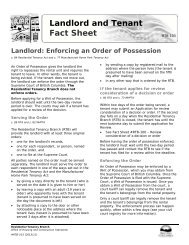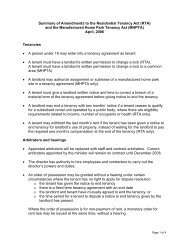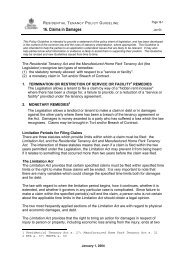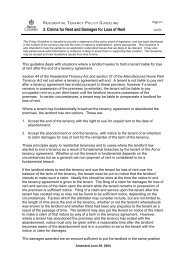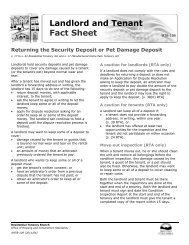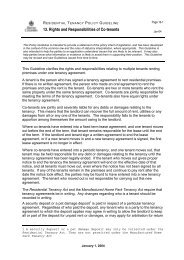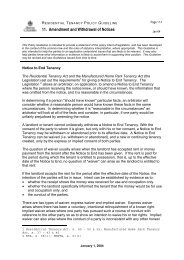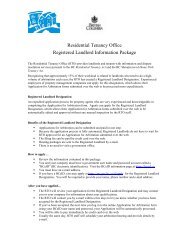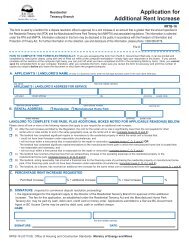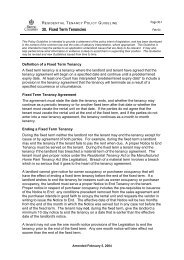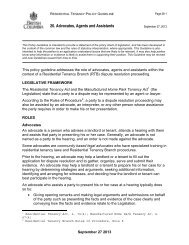37. Rent Increases - Residential Tenancy Office
37. Rent Increases - Residential Tenancy Office
37. Rent Increases - Residential Tenancy Office
Create successful ePaper yourself
Turn your PDF publications into a flip-book with our unique Google optimized e-Paper software.
RESIDENTIAL TENANCY POLICY GUIDELINE<br />
<strong>37.</strong> <strong>Rent</strong> <strong>Increases</strong><br />
Page 37-10<br />
Mar-12<br />
The landlord can request an increase sufficient to cover the loss experienced as a result<br />
of the increase in operating or financing costs. The additional rent increase must apply<br />
equally to all rental units in the building. The application cannot be made until after the<br />
fiscal year end of the rental property, in order that the landlord is able to show the<br />
financial loss incurred.<br />
If an application results from a significant increase in operating expenses 12 , the landlord<br />
must show what costs have increased, provide documentary evidence of the increase in<br />
costs (e.g. invoices for the most recent and the preceding year), and the impact on the<br />
landlord’s financial position. “Operating expenses” includes utility charges (including<br />
heat, hydro, water), municipal taxes (including property and school taxes), recycling,<br />
sewer and garbage fees payable to the local government or other party, insurance<br />
premiums, routine repair and maintenance (including interior painting done on a regular<br />
schedule), reasonable management fees for the management of the residential property,<br />
and the cost of leasing land for purposes directly related to the operation and use of the<br />
residential property. Expenses that are not operating expenses include expenses that<br />
are not related to the normal or usual operation of the residential property, non-recurring<br />
expenses, capital expenses, fines or penalties levied for failure to meet an obligation,<br />
financing costs (including interest expenses and mortgage interest), capital cost<br />
allowance or depreciation, and income taxes. A capital expense means an expenditure<br />
for a repair, renovation, or new addition that has a lasting and long term benefit to the<br />
residential property (including a roof, an appliance, carpets and exterior painting), and<br />
consists of the net cost to the landlord after an allowance for trade-in, if any.<br />
“Extraordinary” means going beyond what is usual or regular, or exceptional to a marked<br />
extent. The landlord must prove the financial loss has incurred from an extraordinary<br />
increase in the operating expenses of the residential property. The extraordinary<br />
increase in operating expenses may be incurred over the landlord’s most recent annual<br />
accounting period, or it may be an increase accumulated over previous accounting<br />
periods and resulting in the financial loss in the most recent accounting period. If, over<br />
the preceding years, a landlord has simply failed to give rent increases to capture rising<br />
operating expenses, the landlord is not allowed to recapture those previously forsaken<br />
expenses.<br />
If an application results from an increase in financing costs 13 , the landlord must prove<br />
that he or she has incurred a financial loss for the financial costs of purchasing the<br />
residential property. The landlord must provide evidence of the new financing costs, the<br />
previous financing costs, and the impact on the landlord’s financial position. The<br />
landlord must prove the financing costs incurred are usual or regular. The landlord must<br />
also explain why the financing costs could not have been foreseen under reasonable<br />
circumstances. The financial loss must be incurred by a landlord acting reasonably in<br />
entering into the agreement or debt with the subject financing costs. “Financing costs”<br />
means the interest and amortization rates attributable to the purchase of the residential<br />
property made in good faith and at arm’s length. The attached Table 1: ‘Chartered Bank<br />
Administered Interest Rates’ provides a guide for determining appropriate interest rates<br />
attributable to purchasing residential property. A landlord incurring financial costs that<br />
12 RT Reg, s. 23(1)(c); MHPT Reg, s. 33(1)(c).<br />
13 RT Reg, s. 23(1)(d); MHPT Reg, s. 33(1)(d).<br />
Updated August 9, 2007



